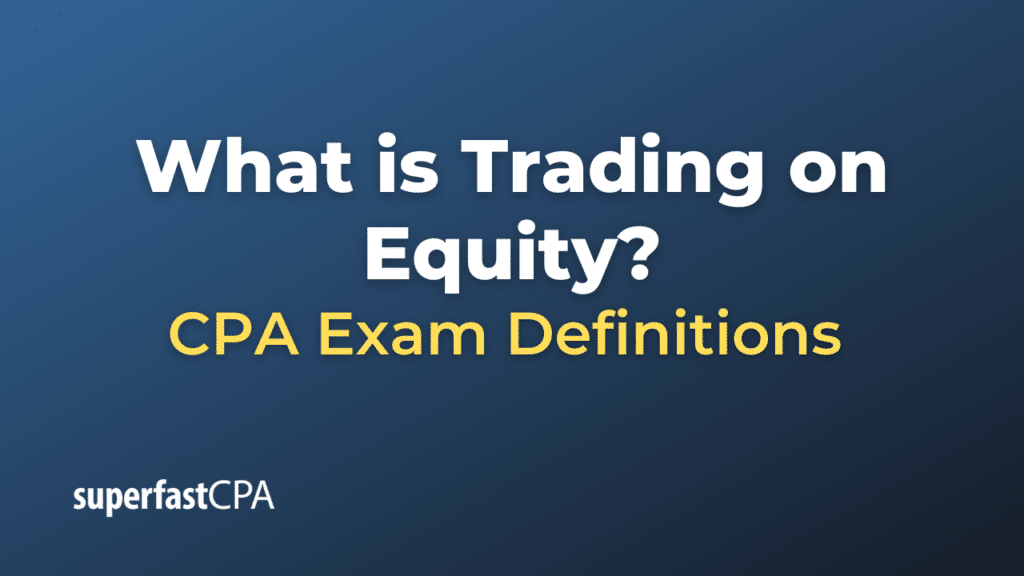Trading on Equity
“Trading on equity” is a financial term that refers to the use of debt (borrowed funds) by a company to finance its operations and investments, with the hope of earning a return on equity that is higher than the interest payable on the debt. Essentially, it’s about leveraging the company’s equity with debt to potentially magnify returns for the equity shareholders.
This concept is grounded in the difference between the return on equity (ROE) and the cost of debt. If a company can borrow money at a lower interest rate than the rate of return it can generate using those borrowed funds, then the excess return accrues to the equity shareholders. This can enhance earnings per share (EPS) and potentially result in increased dividends and stock price appreciation.
For Example:
Imagine a company, ABC Corp, has $1 million of equity and no debt. It earns an ROE of 15%, resulting in a profit of $150,000.
Now, let’s say ABC Corp borrows $1 million at an interest rate of 10% (costing them $100,000 annually) and uses this debt to fund projects that also return 15% (or $150,000 annually).
Without accounting for taxes and other complexities:
- Total earnings from the combined equity and debt would be 0,000 (0,000 from equity-financed operations + 0,000 from debt-financed operations).
- After deducting the interest expense on the debt ($100,000), ABC Corp is left with a profit of $200,000.
- Thus, by trading on equity, ABC Corp increased its profits from $150,000 to $200,000.
However, there are risks:
- Financial Risk: Taking on debt increases the financial risk for a company. If the return on the borrowed funds is lower than the interest expense, it can erode shareholder value and strain the company’s finances.
- Fluctuating Interest Rates: If a company has borrowed at a variable interest rate, rising interest rates can increase the cost of debt and potentially hurt profitability.
- Operational Risk: If the company’s projects or operations (financed by debt) don’t generate the expected returns, it can lead to financial distress and potential bankruptcy.
- Repayment Obligations: Debt obligations come with mandatory repayments, which might strain cash flows, especially if a company faces any unexpected financial challenges.
Thus, while trading on equity can enhance shareholder returns, it must be used judiciously and managed carefully to avoid undue risks.
Example of Trading on Equity
Let’s use a simple hypothetical example to illustrate the concept of trading on equity:
Prestige Enterprises Example:
Initial Scenario:
- Prestige Enterprises has total equity of $500,000.
- It earns a consistent Return on Equity (ROE) of 20%.
- Hence, its earnings (profit) from its equity: 20% of $500,000 = $100,000.
Decision to Leverage: Prestige Enterprises decides to borrow $500,000 at an annual interest rate of 10%. The company believes it can invest this borrowed money into new projects and generate the same 20% return.
Post-borrowing Scenario:
- Earnings from the borrowed funds: 20% of $500,000 = $100,000.
- Interest payable on the borrowed funds: 10% of $500,000 = $50,000.
Overall Earnings:
- Total earnings from equity and debt: $100,000 (equity) + $100,000 (debt) = $200,000.
- After deducting the interest expense: $200,000 – $50,000 = $150,000.
Comparison:
- Earnings before leveraging (using only equity): $100,000.
- Earnings after leveraging (using equity and debt): $150,000.
Conclusion: By trading on equity (leveraging), Prestige Enterprises increased its net earnings from $100,000 to $150,000, which is a 50% increase. However, it’s important to note that while the company enhanced its returns, it also took on more risk in the form of debt. If the return on the new projects financed by the borrowed money had been lower than 10% (the cost of the debt), the company could have faced decreased profitability or potential financial challenges.
This example simplifies several complexities for the sake of clarity. In the real world, factors like taxes (interest expenses can be tax-deductible), changing interest rates, operational risks, and the varying financial structures of companies can influence the outcomes of trading on equity.













